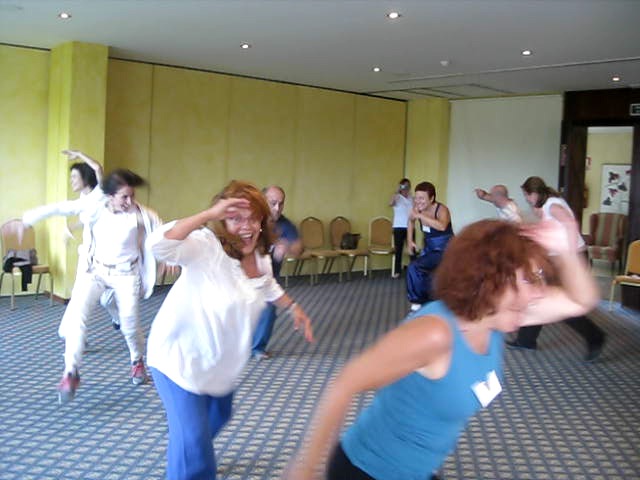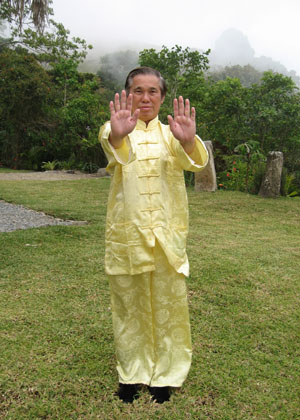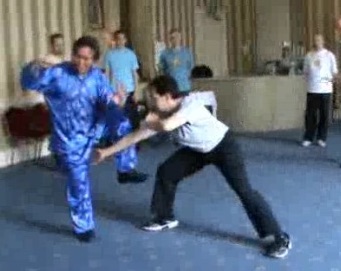SELECTION OF QUESTIONS AND ANSWERS
JUNE 2016 PART 2

Five-Animal Play
Question 1
Can you please give us a historical background of the Five-Animal Play in our school?
— Sifu Leonard Lackinger, Austria
Answer
I read about Five-Animal Play in my young days after I have learned from Sifu Ho Fatt Nam but before I established Shaolin Wahnam Institute. The orthodox belief at that time was Hua Tuo, a great Chinese doctor of the 2nd century, observed the movements of five different types of animals -- the bird, the deer, the monkey, the tiger and the bear -- and taught the imitated movements as chi kung patterns to his students.
One factor of my reading of chi kung classics that had a deep impression in me was that the movements of all the five animals appeared similar, and that the movements did not resemble those of a bird, a deer, a monkey, a tiger or a bear. Indeed, the movements of a bird depicted in some classics, for example, were not different from those of a deer or of any other animals.
However, the chi kung techniques of Five-Animal Play shown in some other books, which I did not hold as high a regard as the classics, resembled more of the animals. As Five-Animal Play did not impress me then, I did not pay much attention to it.
A few years ago, I came across reports that new archaeological evidence in China discovered recently showed new light on Five-Animal Play. The evidence showed that Hua Tuo did not imitate the movements of animals as previously conceived, but the manifestations of his students in chi flow as a result of practicing chi kung exercises taught by him could be classified into five archetypes symbolised by the five animals of the bird, the deer, the monkey, the tiger and the bear.
These manifestations were due to five different internal organs with close relationship with five major types of emotions. The bird movement was related to the heart system and associated with the emotions of joy. The deer movement was related to the liver system and associated with the emotions of anger. The monkey movement was related to the spleen system and associated with the emotions of anxiety. The tiger movement was related to the lung systems and associated with the emotions of sorrow. The bear movement was related to the kidney systems and associated with the emotions of fear.
This suddenly made good sense. Looking back at the chi flow manifestations of my students I noticed that their manifestations could be classified into these five animal movements. There were also movements that defied classification.
Thus, when Adalia suggested that I taught Five-Animal Play in Barcelona in May 2014, I gladly agreed. Since then Five-Animal Play has become popular. I can foresee that Five-animal Play will become a very effective mean to help patients overcome both physical and psychological illness. One, of course, does not have to be sick to enjoy Five-Animal Play, or any chi kung. It is also a lot of fun.
Question 2
Sometimes you ask us to direct our chi flow to certain levels, like the skin level and the muscle level. Sometimes you ask us to let our chi flow freely. Which one should I do?
— Mirano. Spain
Answer
When you practice in a class with me or another instructor guiding you, you do what I or the instructor tell you, which is to your best benefit. For example, if I ask you to direct chi to your skin level, you just follow the instruction as best as you comfortably can and direct your chi to your skin level. If I ask you to let your chi flow freely, you just let your chi flow freely.
You need not worry or intellectualize on how or why you do it. You just do it as best as you comfortably can. If I ask you to direct your chi to your skin level, and you start to worry whether you can do it, or intellectualize on why you should do it, you will miss my heart-to-heart transmission, and you will not be able to have the skill to direct your chi to your skin level in just one training session.
If you practice the technique on your own for many months and if you are lucky, you may eventually develop the skills on your own. Less than 10% of those who practice the techniques correctly for many months or even years will eventually develop the skills on their own. But in a heart-to-heart transmission, if you follow my instructions, including not to worry and not to intellectualize, you will have the skills in less than an hour!
When you practice on your own, after having acquired the skills from my heart-to-heart transmission, you can choose to direct your chi to your skin level, or muscle level or any level. Your choice depends on the purpose of your practice session, your needs, your aspirations, and your whims and fancies.
If the purpose of the session is to direct your chi to your muscles, for example, then you direct your chi to your muscles. If you need or aspire to direct your chi to your meridians, then you direct your chi to your meridians. If you fancy to have your chi flow freely, then you have a free chi flow.
Whatever it is, don't worry, don't intellectualize and enjoy your practice. It is a fact that even if you attain only 30% of what you attained during the Bone Marrow Cleansing course with me, your result is far better than most practitioners.

Cosmic Shower
Question 3
The second item that came up about this whole encounter was how powerless and angry I felt due to my ignorance. I wish that I had learnt more about healing earlier so that I could be more efficient when I tried to help this master and his senior student with healing.
— Frederick, USA
Answer
Why should you feel powerless and angry? You are not trained to be a healer. Being a healer is a profession. It is not meant for amateurs to flatter their ego.
You should be happy for this experience and realization. Even if you had been successful in giving some temporary relief to this master, you might have created a false impression of yourself and cause harm to other people in future.
When you have graduated from medical school, you should treat patients according to your training and ability. As a responsible doctor, if you know a better doctor who can cure your patients more effectively, you should recommend your patients to him.
Editorial Note: This is a continuation of Frederick's questions. His earlier questions can be found at the previous issue, June 2016 Part 1
Question 4
While I could draw off blockages from his body and channel qi into his body, I realized there were so many things I did not know, such as where was the best place to send qi, how to draw away and disperse blockages, how to open energy points, and how to stimulate his own qi flow to help accelerate the healing process.
Answer
You should not transmit chi, or energy, to the master or any person unless you are trained to do so and know what will happen to the person as a result of your chi transmission. If the person's meridians are blocked, or if he is too weak, transmitting chi to him may harm him, or even kill him if done too powerfully or improperly.
You may also harm yourself when you transmit chi to sick persons. Their bad chi can back-flow to you. You do not know how to cleanse off the bad chi, or to prevent it happening.

"Pushing Mountain" is an important technique in the development of Cosmos Palm
Question 5
The master's own qigong mainly emphasises a method where qi is purposefully made to flow to a blockage, rather than the spontaneous qi flow of Shaolin Cosmos Qigong. Ignorant of where a blockage resided might result in the methods of that system not working very well.
Answer
Chi kung healing is much more than letting chi purposefully flow to a blockage, or not knowing what to do if a blockage is unknown.
It seems that the master is an amateur healer. As I have mentioned above, his healing philosophy and mine are different. I believe that healing is a profession, and a healer must be well trained. A healer deals with patients' lives.
Question 6
This whole episode reminded me of your autobiography, the Art of Chi Kung, and the Complete Book of Shaolin, where you described how you trained and used Cosmos Palm in your own healing. For the first time since I learnt about Cosmos Palm, I'm more interested in the healing aspect of that art rather than the ability to inflict an internal injury or breaking a brick with it. I would some day very much love to learn that art and its healing application, ideally from you or from a Shaolin Wahnam master, after I finish the remaining two years of medical school.
Answer
Cosmos Palm has helped me much in my healing work. And I am happy to say that I have helped hundreds of people overcome so-called incurable diseases, like cancer, heart problems, diabetes, chronic viral infection, depression and phobia.
However, you should not learn Cosmos Palm just because it helps in healing. If you wish to be a good chi kung healer, you should undergo all aspects of chi kung healing, which actually is good for you as a Western trained doctor.
But it may be in conflict with your career as a Western trained medical doctor. Your medical council may not allow you to do so.

Grandmaster Wong uses a leg technique to defend a groin-attack from Frederick
Question 7
I also know the importance of proper foundation laying and preparation. Until that day comes, would it be a good idea for me to practice, say, Pushing Mountains and Big Windmill? If so, would you recommend that I follow the program in the Art of Chi Kung, the Complete Book of Shaolin, or some other program to lay a foundation before I can learn the principles in person?
Or would you recommend not practicing those exercises and simply continuing to practice what you have already taught me, e.g. Baguazhang, Lifting Water, Two-Finger Shooting Zen, and stances such as Golden Bridge and Three-Circle Stance?
Answer
I would recommend that you continue to practice what you have already learnt from me. The arts you have learnt are invaluable, and you already have made very good progress. It is unwise to throw away jewels in your hands to look for jewels in the wilderness. You may end with stones.
Question 8
Thank you once again for your insight and wisdom! I wish more people in the world were as lucky as me to be able to call you "Sifu."
Answer
Indeed, students in our school are very lucky. They are able to learn genuine, high-level arts that give them good health, vitality, longevity, mental clarity, peak performance and spiritual joys. They must have done a lot of good deeds to have such good karma.
If you have any questions, please e-mail them to Grandmaster Wong via his Secretary at stating your name, country and e-mail address.
LINKS
Selected Reading
- Shaolin Wahnam Policy on Challenges
- History and Philosophy of 48-Pattern Taijiquan
- Swimming Sragon Baguazhang
- Green Dragon Crescent Moon Guan Dao
- Taxes on the Road
